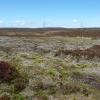35.154 Xenolechia aethiops (Humphreys & Westwood, 1845)
Status and Distribution
Formerly local in parts of southern, south-west and northern England, North Wales and Scotland as far north as the Orkney Islands. Recorded from two localities in central Ireland in the 1980s.
Records submitted to the Recording Scheme covering the period subsequent to 1999 seem to indicate a serious decline in distribution and numbers. Since then only six singletons have been reported in England (from Yorkshire north to Northumberland) in 2012-2022, and from two locations in Scotland (in Angus and Moray). The location in Angus has produced a count of 4 in 2010 and a singleton in 2025.
It is possible data has yet to be submitted or that the species is under-recorded due to the early flight period and unusual habitat requirements (areas of new heather growth in recently burnt locations). Whatever the reason, it would be worthwhile looking for this species at previously known or new locations where heather has been recently burnt to establish if this apparent decline is genuine or not.

Provisional map
Foodplant and Larval Feeding Signs
Erica cinerea (bell heather), see plant distribution map. In Europe it is suggested it may be associated with other Erica species.
At first mines the leaves and then feeds from a silken tube amongst the shoots.
Finding the Moth
Larva: the small larva starts as a leaf miner within the heather. It then constructs a silken tube intermixed with frass and fragments of heather from which it feeds on the leaves
Adult: can be found resting on burnt heather or by sweeping such areas; occasionally attracted to light.
Similar Species
This all black moth is quite variable in size, from 11-17mm in wingspan, but is best distinguished by its narrow, pointed forewings. Blackish specimens of Carpatolechia decorella normally have a yellow subcostal line while dark forms of Teleiopsis diffinis have scattered ochreous scales on the forewing.
Believed to be single brooded flying from the beginning of April to late May. It has also been reported in July from two well separated areas in northern England.
In Europe there have been reports from France in early July, Greece in late July, late August and late September and from Spain on the 20th September.
Earliest: 28th March 2012 (VC68).
Latest: 8th June 1909 (VC96). Also on 9th July 1946 (VC62), 6th July 1957 (VC62) and July (no date specified) 1982 (VC67).









